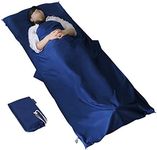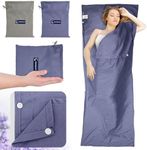Buying Guide for the Best Ultralight Sleeping Bag Liner
Choosing the right ultralight sleeping bag liner can significantly enhance your camping or backpacking experience. A sleeping bag liner adds an extra layer of warmth, keeps your sleeping bag clean, and can even be used on its own in warmer climates. When selecting a liner, consider factors such as material, weight, size, and temperature rating to ensure it meets your specific needs and preferences.MaterialThe material of a sleeping bag liner is crucial as it affects comfort, warmth, and durability. Common materials include silk, cotton, fleece, and synthetic blends. Silk is lightweight and compact, making it ideal for backpackers who prioritize weight and space. Cotton is comfortable and breathable but tends to be heavier and bulkier. Fleece provides extra warmth, suitable for colder conditions, but is also heavier. Synthetic blends offer a balance between weight, warmth, and moisture-wicking properties. Choose a material based on your comfort preference, the climate you'll be in, and how much weight you're willing to carry.
WeightWeight is a critical factor for ultralight backpackers who aim to minimize their load. Sleeping bag liners can range from a few ounces to over a pound. Lighter liners, often made from silk or lightweight synthetics, are perfect for those who need to keep their pack weight to a minimum. Heavier liners, like those made from fleece, are better for situations where warmth is a priority over weight. Consider how much weight you are comfortable carrying and balance it with the level of warmth and comfort you need.
SizeThe size of the sleeping bag liner should match your sleeping bag and your body size to ensure comfort and effectiveness. Liners come in various lengths and widths, so it's important to choose one that fits well inside your sleeping bag without being too tight or too loose. A liner that is too small may restrict movement, while one that is too large may bunch up and be uncomfortable. Consider your height and the dimensions of your sleeping bag when selecting a liner size.
Temperature RatingThe temperature rating of a sleeping bag liner indicates how much additional warmth it can provide. Some liners are designed to add a few degrees of warmth, while others can significantly increase the temperature range of your sleeping bag. If you plan to camp in colder conditions, look for a liner with a higher temperature rating. For warmer climates or summer camping, a liner with a lower temperature rating or one that is primarily for cleanliness and comfort may suffice. Assess the typical temperatures of your camping destinations to choose the appropriate temperature rating.
PackabilityPackability refers to how easily the sleeping bag liner can be compressed and stored in your backpack. This is particularly important for ultralight backpackers who need to maximize space. Liners made from silk or lightweight synthetics usually pack down very small, making them ideal for those with limited space. Fleece liners, while warmer, tend to be bulkier and may take up more room in your pack. Consider how much space you have available and how important packability is to your overall packing strategy.











